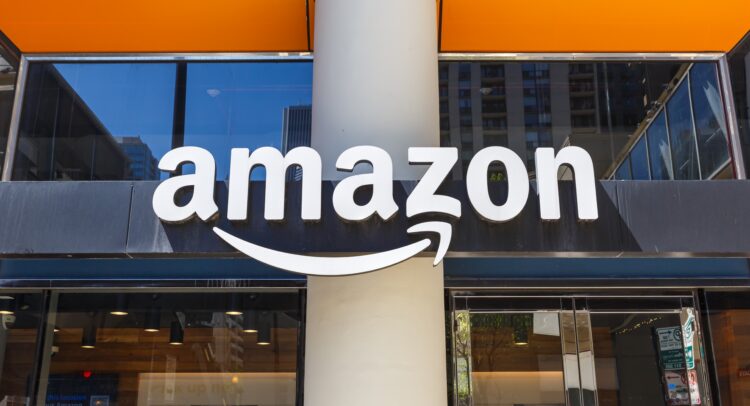Amazon (NASDAQ:AMZN) has seen its free cash flow surge in recent quarters. Following its Q1 earnings, the e-commerce and cloud giant saw its trailing-12-month free cash flow surge, with both segments marking notable improvements. At Amazon’s current rate of growth and margin expansion trajectory, Wall Street forecasts that its free cash flow will reach $100 billion by FY2026, which is certainly possible.
Nevertheless, while this estimate could sustain the stock’s bullish sentiment, I urge investors to exercise caution regarding its valuation. Thus, I am neutral on the stock.
Shopping Experience Improvements Fuel Retail Growth, Operating Profits
Before we examine Amazon’s impressive free cash flow growth, let’s explore the sustained growth across both segments, which fuels this result. Starting with retail, the company focused on improving customers’ shopping experiences in Q1. This led to double-digit revenue growth and notable gains in operating profits. More specifically, the North American retail segment posted sales of $86.3 billion, up 12% year-over-year.

Further, the International retail segment posted sales of $31.9 billion, up 11% in constant currency over the prior-year period.

Management credited this growth to offering a better customer experience, which includes an expanded product selection, competitive pricing, and improved convenience. Amazon ramped up product events and widened its premium and luxury brand offerings while improving Prime delivery speeds.
Additionally, it strengthened efforts to draw in more third-party sellers, leading to the third-party seller unit mix surging to 61% in Q1, marking a 200 basis point increase. As a result, Services revenues grew by 16% compared to last year. Further, third-party selling offers higher yields because Amazon collects hefty fees while the seller incurs most of the costs.
Evidently, the North American segment’s operating income approached almost $5 billion, up 557% year-over-year. The segment’s operating margin came in at 5.8%, celebrating a 460 basis point increase. The International segment’s operating income also improved greatly, coming in at $903 million compared to an operating loss of $1.23 billion last year.
Amazon Web Services Posts Exceptional Top- and Bottom-Line Growth
Besides the strong sales and operating income seen in its retail segment, Amazon Web Services’ cloud segment also posted exceptional top-and-bottom-line growth. Segment revenue was $25.0 billion, up 17% year-over-year, and AWS now boasts a $100 billion annualized revenue run rate.

Meanwhile, the company continues to reap the rewards of its persistent focus on cost optimization. The results are apparent, with the bulk of recent optimizations now nearing completion. Operating expenses in Amazon Web Services decreased by 3.1% compared to last year, totaling $15.6 billion. The combination of strong revenue growth and a decline in expenses led to the segment’s operating income skyrocketing by 84% to $9.4 billion.
Free Cash Flow Heading to $100 Billion, But Valuation Concerns Remain
Amzon’s Q1 results showcased exceptional operating income growth in both its Retail and AWS segments. In the meantime, its capital expenditures (CapEx) grew at a much softer rate, by just 5% to $14.9 billion. Accordingly, this was another significant free cash flow expansion period for the company.
In particular, free cash flow improved to an inflow of $50.1 billion for the trailing 12 months, a massive difference compared with an outflow of $3.3 billion for the trailing 12 months of the prior year period. Amazon has now demonstrated a rather prolonged free cash flow expansion trajectory, encouraging Wall Street to employ quite optimistic estimates.

To be exact, consensus estimates see free cash flow reaching $62.4 billion, $79.0 billion, and $102.7 billion in Fiscal years 2024, 2025, and 2026, respectively. This seems like an absolutely unreal milestone for the company, which is likely to keep fueling the stock’s bullish sentiment.
Nevertheless, I would urge investors to be mindful of the stock’s valuation. At today’s prices, Amazon is trading at essentially 31.5 times this year’s expected free cash flow. Even if Amazon does reach the $100 billion free cash flow milestone by FY2026, a price-to-free-cash-flow multiple of about 20 times three years out isn’t exactly attractive.
That’s particularly true, given where interest rates are currently hovering. Thus, while I praise Amazon for its operational excellence lately, make sure you are aware of a potential overvaluation at its current levels.
Is AMZN Stock a Buy, According to Analysts?
Turning to Wall Street, Amazon still boasts a Strong Buy consensus rating. Impressively, this is based on 41 unanimous Buys assigned in the past three months. At $219.50, the average Amazon stock forecast suggests 16.8% upside potential.
If you’re unsure which analyst you should follow if you want to buy and sell AMZN stock, the most accurate analyst for the stock (on a one-year timeframe) is Rob Sanderson from Loop Capital Markets, with an average return of 34.44% per rating and a 91% success rate. Click on the image below to learn more.

The Takeaway
Overall, Amazon’s remarkable performance in Q1, especially in its Retail and AWS segments, undoubtedly highlights its potential to generate tremendous free cash flow. Given its growth trajectory, Wall Street’s projections of its free cash flow reaching $100 billion by FY2026 appear plausible.
Nevertheless, I believe investors should exercise caution against the stock’s current valuation. Amazon’s overall qualities and profitability prospects remain particularly compelling, but it could be the case that investors are overpaying for the stock at its current levels.









